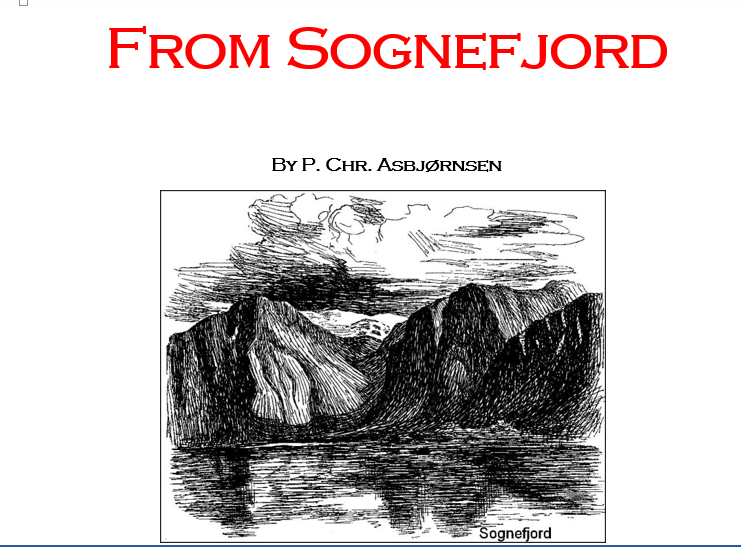Introduction
Most Norwegians, as well as tourists visiting Norway, observe a picture of Peter Christen Asbjørnsen (1812-1885) every time they reach in their wallets for a 50 kroner banknote; but few reflect on the tradition which the author stands for. Together with Jørgen Moe, he is primarily responsible for giving Norway a rich folk-tale tradition.
Asbjørnsen was born in 1812 in Kristiania (now Oslo), and went to school in Norderhov, in Ringerike, in 1826. It was here he met and formed an important friendship with Jørgen Moe, when they were both still schoolboys. Asbjørnsen and Moe had read Grimm’s Kinder und Hausmärchen, and they wrote a letter to Jacob Grimm in 1844, where they stated that the German collection of folktales had given them the idea of writing their own collection of Norwegian folktales. The first volume of Norwegian Folk Tales was published a year later, in 1845. They collected their tales by travelling around Norway, recording an oral tradition that was in the process of dying out.
From Sognefjord
Asbjørnsen and Moe are best known for Norwegian Folk Tales. However, Asbjørnsen also employed his creative skills in retelling sagas and tales. These are well-represented in his Norske Huldreeventyr og Folkesagn (Norwegian Fairy Tales and Folk Legends), which was published in 1845 and revised in 1870; it is from this collection that the narrative ‘From Sognefjord’ is taken.
In ‘From Sognefjord’, Asbjørnsen describes the characters, traditions, legends, myths, and customs of Sognefjord, as well as its magnificent scenery. These elements are woven together into a narrative; a kind of travelogue along Sognefjord. The author, as first person narrator, hires some local characters to row him along the fjord. The main character is Bård in the Shade (‘Bård i Skuggjen), a person who appears to have been created by the author from a mixture of personal experience and imagination. The boat party takes a rest from rowing along the fjord. They make a campfire near the shore, entertaining each other with tales of trolls and spirits. When they set off again, they meet a wedding party on the fjord and the beer flows freely ….
In order to retain a feeling authenticity in his writing, Asbjørnsen often used words associated with specific dialects. In ‘From Sognefjord’, the local dialect of the people of Sogn, Sognemål, is spoken by the local folk hired by the author. The narrative is written in the national romantic tradition, as illustrated by the use of dialect, legend, myth and poetic descriptions of the natural surroundings. One example of the use of legend and myth in the narrative is the reference to the julaskreii (åsgårdsrei), a local, pagan, Yuletide myth and tradition; which takes place on December 13th. It coincides, and has much in common with, the wider tradition of Saint Lucia’s Night. On this night, according to the julaskreii tradition, ghosts are said to ride by horseback on a drunken rampage over the countryside. Associations with the devil are also explicit, i.e. references to ‘Old Nick’, or nøkken. In contrast to the folktales, which record an oral tradition, ‘From Sognefjord’ interestingly utilizes all the elements of folklore: character, legend, myth, and tradition; and transforms them into a fascinating narrative.
Translation and Illustrations
The translation was done by Ian Harkness. The illustrations were drawn by Ridley Borchgrevink who illustrated the 1934 edition of Asbjørnsen’s Huldreveventyr. They are used in this booklet with the kind permission of Ridley Borchgrevink’s niece, Sophie Nordrum.
The brisk breeze, which earlier in the day had blown in over the Sognefjord bringing coolness from the sea, gradually died down, and the heat and humidity became almost unbearable for my people, who had been working the oars or dredging the depths of the fjord for sea creatures since early morning. Evening was approaching, and I knew that I could not reach my destination before morning, and so I decided to take the boat ashore at the first landing point we came to, and take some evening refreshment and rest a while until the cool of the late evening or night. The oar strokes now fell longer and stronger, and the boat surged swiftly over the fjord’s gleaming and glistening green surface towards the nearest point of land. It did not appear to be such a long way away, yet it took some time before we reached there, for the clear air, steep mountains and the strange majesty of the surroundings fooled us into misjudging the distance more than usual.
We finally arrived. It is lush and green on this headland, a rich carpet of moss and grass, soft and inviting like silk and velvet. In the bay along the beach stands an ancient oak; its gnarled branches and great crown of foliage arch over the moss-covered roof of a tumbledown boathouse and the aged hull of a stranded coastal trader, half-hidden in a thicket of hazel and briars. The massive and dark crown of the tree stands out sharply against the delicate and light tracery of the weeping birches, which together with the wild apple and other deciduous trees cover the steep slopes and encompass a lustrous green clearing, where a barn shelters under an overhanging rock face. A gentle whispering passes through the woods and the hazel copse; it is almost certainly the woodland spirits ringing in vespers with the foxgloves, for the purple-tinted rows of bells swing to and fro, while not a breath of wind can be felt.
to download the full document click on the download button

